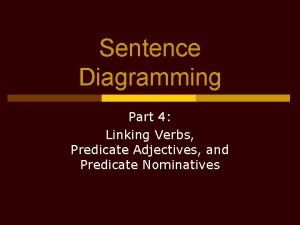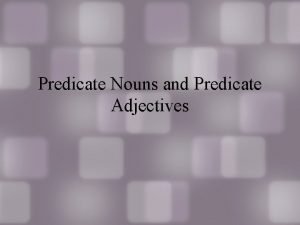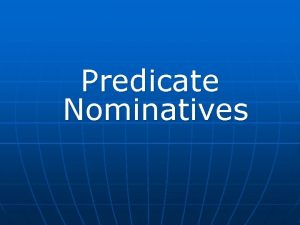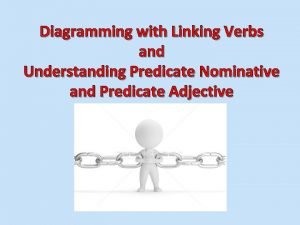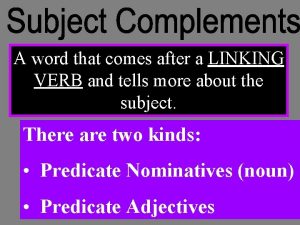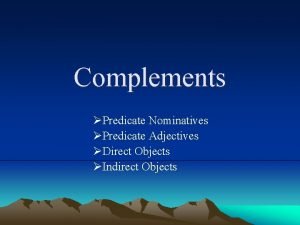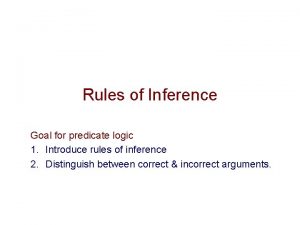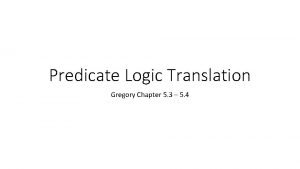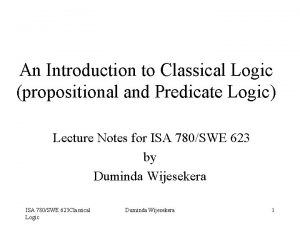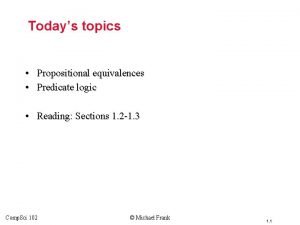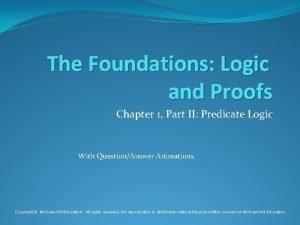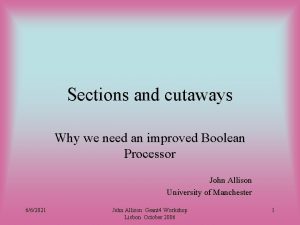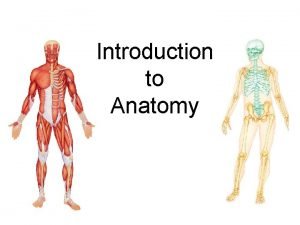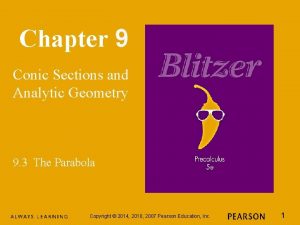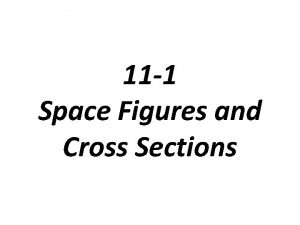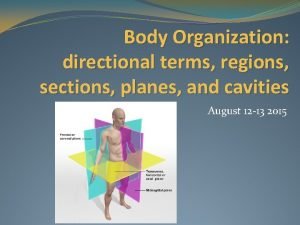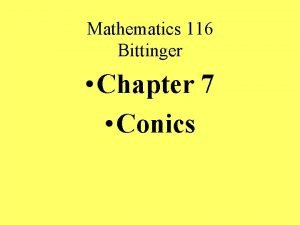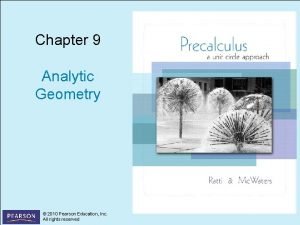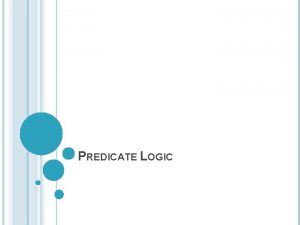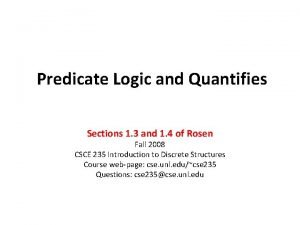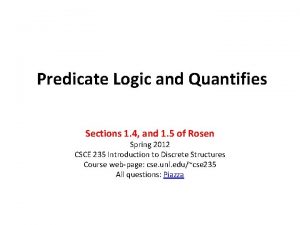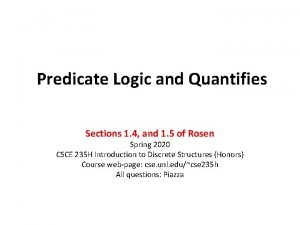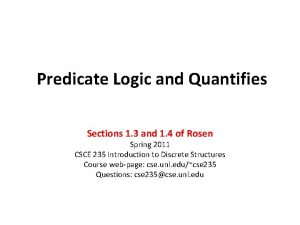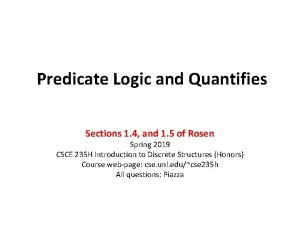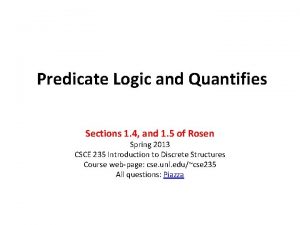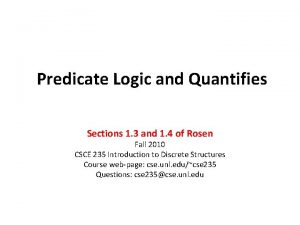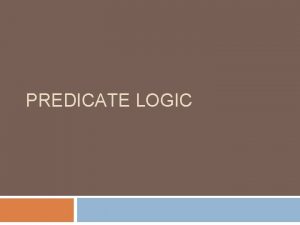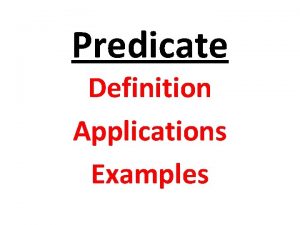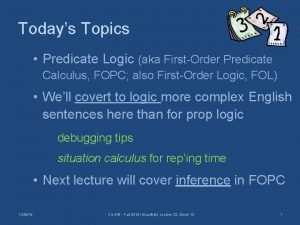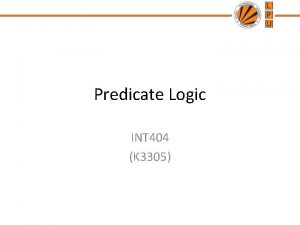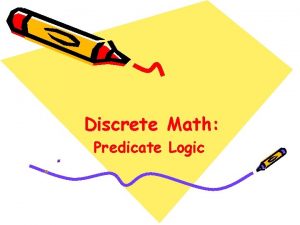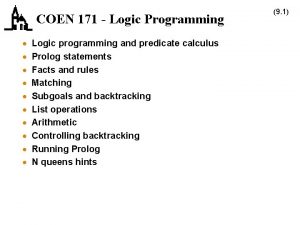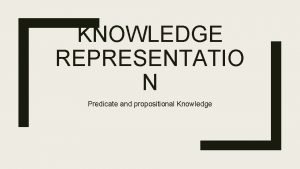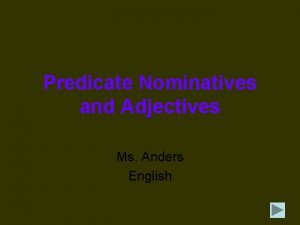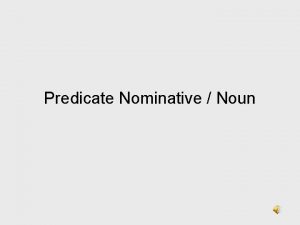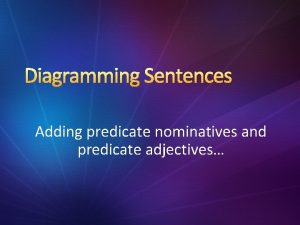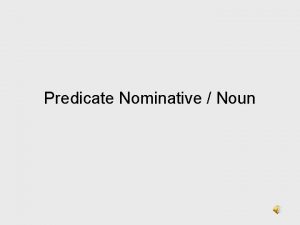Predicate Logic and Quantifies Sections 1 3 and







































- Slides: 39

Predicate Logic and Quantifies Sections 1. 3 and 1. 4 of Rosen Spring 2010 CSCE 235 Introduction to Discrete Structures Course web-page: cse. unl. edu/~cse 235 Questions: cse 235@cse. unl. edu

La. Te. X • Using the package: usepackage{amssymb} – Set of natural numbers: $mathbb{N}$ – Set of integer numbers: $mathbb{Z}$ – Set of rational numbers: $mathbb{Q}$ – Set of real numbers: $mathbb{R}$ – Set of complex numbers: $mathbb{C}$ CSCE 235, Spring 2010 Predicate Logic and Quantifiers 2

Outline • Introduction • Terminology: – Propositional functions; arguments; arity; universe of discourse • Quantifiers – Definition; using, mixing, negating them • Logic Programming (Prolog) • Transcribing English to Logic • More exercises CSCE 235, Spring 2010 Predicate Logic and Quantifiers 3

Introduction • Consider the statements: x>3, x=y+3, x+y=z • The symbols >, +, = denote relations between x and 3, x, y, and 4, and x, y, and z, respectively • These relations may hold or not hold depending on the values that x, y, and z may take. • A predicate is a property that is affirmed or denied about the subject (in logic, we say ‘variable’ or ‘argument’) of a statement • Consider the statement : ‘x is greater than 3’ – ‘x’ is the subject – ‘is greater than 3’ is the predicate CSCE 235, Spring 2010 Predicate Logic and Quantifiers 4

Propositional Functions (1) • To write in Predicate Logic ‘x is greater than 3’ – We introduce a functional symbol for the predicate and – Put the subject as an argument (to the functional symbol): P(x) • Terminology – P(x) is a statement – P is a predicate or propositional function – x as an argument CSCE 235, Spring 2010 Predicate Logic and Quantifiers 5

Propositional Functions (2) • Examples: – – Father(x): unary predicate Brother(x. y): binary predicate Sum(x, y, z): ternary predicate P(x, y, z, t): n-ary predicate CSCE 235, Spring 2010 Predicate Logic and Quantifiers 6

Propositional Functions (3) • Definition: A statement of the form P(x 1, x 2, …, xn) is the value of the propositional symbol P. • Here: (x 1, x 2, …, xn) is an n-tuple and P is a predicate • We can think of a propositional function as a function that – – Evaluates to true or false Takes one or more arguments Expresses a predicate involving the argument(s) Becomes a proposition when values are assigned to the arguments CSCE 235, Spring 2010 Predicate Logic and Quantifiers 7

Propositional Functions: Example • Let Q(x, y, z) denote the statement ‘x 2+y 2=z 2’ – What is the truth value of Q(3, 4, 5)? Q(3, 4, 5) is true – What is the truth value of Q(2, 2, 3)? Q(2, 3, 3) is false – How many values of (x, y, z) make the predicate true? There are infinitely many values that make the proposition true, how many right triangles are there? CSCE 235, Spring 2010 Predicate Logic and Quantifiers 8

Universe of Discourse • Consider the statement ‘x>3’, does it make sense to assign to x the value ‘blue’? • Intuitively, the universe of discourse is the set of all things we wish to talk about; that is the set of all objects that we can sensibly assign to a variable in a propositional function. • What would be the universe of discourse for the propositional function below be: Enrolled. CSE 235(x)=‘x is enrolled in CSE 235’ CSCE 235, Spring 2010 Predicate Logic and Quantifiers 9

Universe of Discourse: Multivariate functions • Each variable in an n-tuple (i. e. , each argument) may have a different universe of discourse • Consider an n-ary predicate P: P(r, g, b, c)= ‘The rgb-values of the color c is (r, g, b)’ • Example, what is the truth value of – P(255, 0, 0, red) – P(0, 0, 255, green) • What are the universes of discourse of (r, g, b, c)? CSCE 235, Spring 2010 Predicate Logic and Quantifiers 10

Outline • Introduction • Terminology: – Propositional functions; arguments; arity; universe of discourse • Quantifiers – Definition; using, mixing, negating them • Logic Programming (Prolog) • Transcribing English to Logic • More exercises CSCE 235, Spring 2010 Predicate Logic and Quantifiers 11

Quantifiers: Introduction • The statement ‘x>3’ is not a proposition • It becomes a proposition – When we assign values to the argument: ‘ 4>3’ is false, ‘ 2<3’ is true, or – When we quantify the statement • Two quantifiers – Universal quantifier $forall$ the proposition is true for all possible values in the universe of discourse – Existential quantifier $exists$ the proposition is true for some value(s) in the universe of discourse CSCE 235, Spring 2010 Predicate Logic and Quantifiers 12

Universal Quantifier: Definition • Definition: The universal quantification of a predicate P(x) is the proposition ‘P(x) is true for all values of x in the universe of discourse. ’ We use the notation: x P(x), which is read ‘for all x’. • If the universe of discourse is finite, say {n 1, n 2, …, nk}, then the universal quantifier is simply the conjunction of the propositions over all the elements x P(x) P(n 1) P(n 2) … P(nk) CSCE 235, Spring 2010 Predicate Logic and Quantifiers 13

Universal Quantifier: Example 1 • Let P(x): ‘x must take a discrete mathematics course’ and Q(x): ‘x is a CS student. ’ • The universe of discourse for both P(x) and Q(x) is all UNL students. • Express the statements: – “Every CS student must take a discrete mathematics course. ” x Q(x) P(x) – “Everybody must take a discrete mathematics course or be a CS student. ” x ( P(x) Q(x) ) – “Everybody must take a discrete mathematics course and be a CS student. ” x ( P(x) Q(x) ) Are these statements true or false? CSCE 235, Spring 2010 Predicate Logic and Quantifiers 14

Universal Quantifier: Example 2 • Express the statement: ‘for every x and every y, x+y>10’ • Answer: – Let P(x, y) be the statement x+y>10 – Where the universe of discourse for x, y is the set of integers – The statement is: x y P(x, y) • Shorthand: x, y P(x, y) CSCE 235, Spring 2010 Predicate Logic and Quantifiers 15

Existential Quantifier: Definition • Definition: The existential quantification of a predicate P(x) is the proposition ‘There exists a value x in the universe of discourse such that P(x) is true. ’ We use the notation: x P(x), which is read ‘there exists x’. • If the universe of discourse is finite, say {n 1, n 2, …, nk}, then the existential quantifier is simply the disjunction of the propositions over all the elements x P(x) P(n 1) P(n 2) … P(nk) CSCE 235, Spring 2010 Predicate Logic and Quantifiers 16

Existential Quantifier: Example 1 • Let P(x, y) denote the statement ‘x+y=5’ • What does the expression x y P(x, y) mean? • Which universe(s) of discourse make it true? CSCE 235, Spring 2010 Predicate Logic and Quantifiers 17

Existential Quantifier: Example 2 • Express the statement: ‘there exists a real solution to ax 2+bxc=0’ • Answer: – Let P(x) be the statement x= (-b (b 2 -4 ac))/2 a – Where the universe of discourse for x is the set of real numbers. Note here that a, b, c are fixed constants. – The statement can be expressed as x P(x) • What is the truth value of x P(x)? – It is false. When b 2<4 ac, there are no real number x that can satisfy the predicate • What can we do so that x P(x)is true? – Change the universe of discourse to the complex numbers, C CSCE 235, Spring 2010 Predicate Logic and Quantifiers 18

Quantifiers: Truth values • In general, when are quantified statements true or false? Statement True when… x P(x) CSCE 235, Spring 2010 False when. . . There is an x for which P(x) is true for every x P(x) is false There is an x for which P(x) is false for every x P(x) is true Predicate Logic and Quantifiers 19

Mixing quantifiers (1) • Existential and universal quantifiers can be used together to quantify a propositional predicate. For example: x y P(x, y) is perfectly valid • Alert: – The quantifiers must be read from left to right – The order of the quantifiers is important – x y P(x, y) is not equivalent to y x P(x, y) CSCE 235, Spring 2010 Predicate Logic and Quantifiers 20

Mixing quantifiers (2) • Consider – x y Loves (x, y): Everybody loves somebody – y x Loves(x, y): There is someone loved by everyone • The two expressions do not mean the same thing • ( y x Loves(x, y)) ( x y Loves (x, y)) but the converse does not hold • However, you can commute similar quantifiers – x y P(x, y) is equivalent to y x P(x, y) (thus, x, y P(x, y)) – x y P(x, y) is equivalent to y x P(x, y) (thus x, y P(x, y)) CSCE 235, Spring 2010 Predicate Logic and Quantifiers 21

Mixing Quantifiers: Truth values Statement True when. . . False when. . . P(x, y) is true for every x y P(x, y) pair x, y There is at least one pair x, y for which P(x, y) is false x y P(x, y) For every x, there is a y for which P(x, y) is true There is an x for which P(x, y) is false for every y x y P(x, y) There is an x for which P(x, y) is true for every y For every x, there is a y for which P(x, y) is false x y. P(x, y) There is at least one pair P(x, y) is false for every pair x, y for which P(x, y) is true x, y CSCE 235, Spring 2010 Predicate Logic and Quantifiers 22

Mixing Quantifiers: Example (1) • Express, in predicate logic, the statement that there is an infinite number of integers • Answer: ‒ Let P(x, y) be the statement that x<y ‒ Let the universe of discourse be the integers, Z ‒ The statement can be expressed by the following x y P(x, y) CSCE 235, Spring 2010 Predicate Logic and Quantifiers 23

Mixing Quantifiers: Example (2) • Express the commutative law of addition for R • We want to express that for every pair of reals, x, y, the following holds: x+y=y+x • Answer: ‒Let P(x, y) be the statement that x+y ‒ Let the universe of discourse be the reals, R ‒ The statement can be expressed by the following x y (P(x, y) P(y, x)) Alternatively, x y (x+y = y+x) CSCE 235, Spring 2010 Predicate Logic and Quantifiers 24

Mixing Quantifiers: Example (3) • Express the multiplicative law for nonzero reals R {0} • We want to express that for every real number x, there exists a real number y such that xy=1 • Answer: x y (xy = 1) CSCE 235, Spring 2010 Predicate Logic and Quantifiers 25

Mixing Quantifiers: Example (4) false mathematical statement • Does commutativity for substraction hold over the reals? • That is: does x-y=y-x for all pairs x, y in R? • Express using quantifiers x y (x-y = y-x) CSCE 235, Spring 2010 Predicate Logic and Quantifiers 26

Mixing Quantifiers: Example (5) • Express the statement as a logical expression: “There is a number x such that when it is added to any number, the result is that number and if it is multiplied by any number, the result is x” as a logical expression • Answer: • • Let P(x, y) be the expression “x+y=y” Let Q(x, y) be the expression “xy=x” The universe of discourse is N, Z, R, Q (but not Z+) Then the expression is: x y P(x, y) Q(x, y) Alternatively: x y (x+y=y) (xy = x) CSCE 235, Spring 2010 Predicate Logic and Quantifiers 27

Outline • Introduction • Terminology: – Propositional functions; arguments; arity; universe of discourse • Quantifiers – Definition; using, mixing, biding, negating them • Logic Programming (Prolog) • Transcribing English to Logic • More exercises CSCE 235, Spring 2010 Predicate Logic and Quantifiers 28

Binding Variables • When a quantifier is used on a variable x, we say that x is bound • If no quantifier is used on a variable in a predicate statement, the variable is called free • Examples – In x y. P(x, y), both x and y are bound – In x. P(x, y), x is bound but y is free • A statement is called a well-formed formula, when all variables are properly quantified CSCE 235, Spring 2010 Predicate Logic and Quantifiers 29

Binding Variables: Scope • The set of all variables bound by a common quantifier is called the scope of the quantifier • For example, in the expression x, y z. P(x, y, z, c) – What is the scope of existential quantifier? – What is the scope of universal quantifier? – What are the bound variables? – What are the free variables? – Is the expression a well-formed formula? CSCE 235, Spring 2010 Predicate Logic and Quantifiers 30

Negation • We can use negation with quantified expressions as we used them with propositions • Lemma: Let P(x) be a predicate. Then the followings hold: ( x P(x)) x P(x) • This is essentially the quantified version of De Morgan’s Law (when the universe of discourse is finite, this is exactly De Morgan’s Law) CSCE 235, Spring 2010 Predicate Logic and Quantifiers 31

Negation: Truth Values of Negated Quantifiers Statement True when… x P(x) is false for every x x P(x) False when. . . There is an x for which P(x) is true x P(x) There is an x for which x P(x) is false P(x) is true for every x CSCE 235, Spring 2010 Predicate Logic and Quantifiers 32

Outline • Introduction • Terminology: – Propositional functions; arguments; arity; universe of discourse • Quantifiers – Definition; using, mixing, negating them • Logic Programming (Prolog) • Transcribing English to Logic • More exercises CSCE 235, Spring 2010 Predicate Logic and Quantifiers 33

Prolog (1) • Prolog (Programming in Logic) is a programming language based on (a restricted form of) Predicate Logic (a. k. a. Predicate Calculus and FOL) • It was developed by the logicians of the Artificial Intelligence community for symbolic reasoning CSCE 235, Spring 2010 Predicate Logic and Quantifiers 34

Prolog (2) • Prolog allows the users to express facts and rules • Facts are propositional functions: student(mia), enrolled(mia, cse 235), instructor(patel, cse 235), etc. • Rules are implications with conjunctions: teaches(X, Y) : - instructor(X, Z), enrolled(Y, Z) • Prolog answers queries such as: ? enrolled(mia, cse 235) ? enrolled(X, cse 476) ? teaches(X, mia) by binding variables and doing theorem proving (i. e. , applying inference rules) as we will see in Section 1. 5 CSCE 235, Spring 2010 Predicate Logic and Quantifiers 35

English into Logic • Logic is more precise than English • Transcribing English into Logic and vice versa can be tricky • When writing statements with quantifiers, usually the correct meaning is conveyed with the following combinations: Use with x Lion(x) Fierce(x): Every lion is fierce x Lion(x) Fierce(x): Everyone is a lion and everyone is fierce Use with x Lion(x) Vegan(x): Holds when you have at least one vegan lion x Lion(x) Vegan(x): Holds when you have vegan people in the universe of discourse (even though there is no vegan lion in the universe of discourse ) CSCE 235, Spring 2010 Predicate Logic and Quantifiers 36

More exercises (1) • Rewrite the following expression, pushing negation inward: x ( y z P(x, y, z) z y P(x, y, z)) • Answer: x ( y z P(x, y, z) z y P(x, y, z)) CSCE 235, Spring 2010 Predicate Logic and Quantifiers 37

More Exercises (2) • Let P(x, y) denote ‘x is a factor of y’ where – x {1, 2, 3, …} and y {2, 3, 4, …} • Let Q(x, y) denote: – x, y [P(x, y) (x=1)] • Question: When is Q(x, y) true? CSCE 235, Spring 2010 Predicate Logic and Quantifiers 38

Alert… • Some students wonder if: x, y P(x, y) ( x P(x, y)) ( y P(x, y)) • This is certainly not true. – In the left-hand side, both x, y are bound. – In the right-hand side, • In the first predicate, x is bound and y is free • In the second predicate, y is bound and x is free • Thus, the left-hand side is a proposition, but the right-hand side is not. They cannot be equivalent • All variables that occur in a propositional function must be bound to turn it into a proposition CSCE 235, Spring 2010 Predicate Logic and Quantifiers 39
 Predicate nominative examples
Predicate nominative examples Predicate nouns and predicate adjectives
Predicate nouns and predicate adjectives Predicate nominative
Predicate nominative Diagramming predicate adjectives
Diagramming predicate adjectives What comes after a linking verb
What comes after a linking verb Predicate nominatives and predicate adjectives
Predicate nominatives and predicate adjectives Simple vs complete predicate
Simple vs complete predicate Predicate logic rules of inference
Predicate logic rules of inference Predicate logic translator
Predicate logic translator Predicate logic example
Predicate logic example Only one student failed in mathematics fol
Only one student failed in mathematics fol Predicate logic equivalence
Predicate logic equivalence First order logic examples in ai
First order logic examples in ai Example of predicate logic
Example of predicate logic Universal quantifier
Universal quantifier First order logic vs propositional logic
First order logic vs propositional logic First order logic vs propositional logic
First order logic vs propositional logic First order logic vs propositional logic
First order logic vs propositional logic Combinational vs sequential logic
Combinational vs sequential logic Tw
Tw Software development plan
Software development plan Combinational logic sequential logic
Combinational logic sequential logic Combinational logic sequential logic 차이
Combinational logic sequential logic 차이 Combinational logic sequential logic
Combinational logic sequential logic Cutaways and cross sections definition
Cutaways and cross sections definition Adduction
Adduction Regional and directional terms
Regional and directional terms Chapter 9 conic sections and analytic geometry
Chapter 9 conic sections and analytic geometry 11-1 space figures and cross sections
11-1 space figures and cross sections Health and safety at work act 1974 sections
Health and safety at work act 1974 sections Marie earns an 8 commission for selling appliances
Marie earns an 8 commission for selling appliances Milady chapter 16 haircutting
Milady chapter 16 haircutting Volumes of solids with known cross sections calculator
Volumes of solids with known cross sections calculator Directional terms planes and sections
Directional terms planes and sections Body planes and sections
Body planes and sections Chapter 7 conic sections and parametric equations
Chapter 7 conic sections and parametric equations Chapter 9 conic sections and analytic geometry
Chapter 9 conic sections and analytic geometry Volume of solids with known cross sections
Volume of solids with known cross sections Think on these things
Think on these things Declaration of independence sections
Declaration of independence sections
